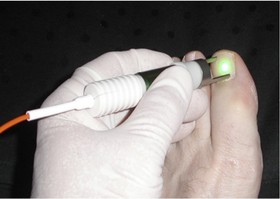What is the best treatment for toenail fungus?
If you are puzzled by all of the treatment options for toenail fungus, you are not alone. There are many advertisements on television, radio and even in the newspaper touting the best way to treat toenail fungus. But the truth is that there are many ways to rid your toes of the infecting fungus that makes the toenails yellow, thick and ugly. You just have to understand all of the treatment options and then you can make the best choice about which fungal treatment is right for you.
Topical Anti-Fungal Medications

What is a topical anti-fungal medication?
A topical anti-fungal medication is one that is applied directly to the toenails, much like nail polish. They are available in both prescription and over-the-counter formulations. Whether you buy it off the shelf at the grocery store or fill a prescription from a doctor, the topical anti-fungal medication is supposed to either kill the fungus that lives in the toenail, or prevent it from growing.
What are the advantages of topical anti-fungal medications?
1. Low cost. Least expensive of all fungal toenail treatments.
2. Low risk. Very little risk of systemic absorption that could affect your liver, other organs or overall health.
3. Available everywhere, even without a prescription. Next time you are line at the drug store or pharmacy, you may notice that there is some type of topical anti-fungal treatment for sale right there next to the chewing gum and candy bars. It is even available at many grocery stores. Some podiatrists often sell over-the-counter topical medications to patient's right in the doctor's office. You can even order topical medications online.
What are the disadvantages of topical anti-fungal medications?
1. Least effective treatment.
2. Takes a long time to work.
3. Takes diligence and patience. Not great for those with busy lives and hectic schedules.
How much do topical anti-fungal medications cost?
Topical antifungal toenail medications may cost less than $20 but can cost over $100 per bottle for the prescription medications. You should expect to use several bottles over the whole course of topical treatment. The total cost could be under $100 but may cost several hundred dollars if you use the most effective prescription topical medication.
How long does it take for a topical anti-fungal medication to cure the fungus?
Many months to more than one year.
How fast will I see results with a topical anti-fungal medication?
Slowly, very slowly. Assuming that you have actually a) chosen a topical antifungal medication that will penetrate through the nail plate to reach the fungus, b) the medication you have chosen is capable of killing the fungus and c) you have the patience to and persistence to apply the medication daily, the toenail will start to grow out and appear clear or healthy at the rate of about 1mm per month. That means that if the whole toenail is infected with fungus it may take 10-12 months for the toenail to become clear and normal looking.
Oral Anti-Fungal Medications

What is an oral anti-fungal medication to treat toenail fungus?
Oral anti-fungal drugs have been around for a long time. However, the older drugs are so toxic that they are almost worse than the disease. The newest (and now most-often prescribed) oral medication for the treatment of toenail fungus is Lamisil (also known as Terbinafine). Lamisil is a pill that you take by mouth every day for 3 months. The concern with Lamisil is that it has been associated with liver problems including complete liver failure, and leading to a liver transplant. Because of this you must have blood tests to check your liver function if you choose to take Lamisil to treat your fungal toenails.
What are the advantages of oral anti-fungal medications?
1. Low hassle. All you have to do is take a pill every day for a few months.
2. Can be effective. Clinical studies show Lamisil to have an effectiveness of 38% to 70%, depending upon how you define "effectiveness." In 70% of patients, there appeared to be no live fungus that could be identified under a microscope or grown in a culture, but there was still some abnormal appearance of the toenail. However only 38% of patients taking Lamisil experienced complete clearing of the toenail and a full return to normal appearance in addition to having no identifiable fungus when the toenail was tested after taking the drug.
3. Insurance may pay for it, but certainly not always. Check with your insurance carrier or pharmacy.
What are the disadvantages of oral anti-fungal medications?
1. Highest risk of liver problems. All oral antifungal drugs have been associated with liver problems. You cannot take the drug if you have any history of liver problems, hepatitis, or alcohol abuse. It is also best to abstain from drinking alcohol while taking Lamisil.
2. Takes a long time to work. Even if the drug does work, it will take months for the toenail to look normal again.
3. High cost. Oral antifungal drugs and the associated liver function tests can be expensive.
How much do oral anti-fungal medications cost?
Lamisil pills are available for a wide range of cost. The name-brand drug is expensive and can cost over $4,000 for the three-month course of medication. The patent on Lamisil's formulation ran out some time ago, so it is possible to get Lamisil in a generic form that is less expensive. The lowest cost that we have found online for the generic version was for about $.30 per pill, or roughly $30 for the three month course of treatment. If you choose to buy online, make sure that you are dealing with a reliable source to help ensure that you don't get bootleg Lamisil made in Cambodia or Pakistan. Aside from the cost of the pills, you also have to consider the cost for the doctor's visits and blood tests (before, during, and after treatment) to make sure your don't have any damage to your liver.
How long does it take for an oral anti-fungal medication to cure the toenail fungus?
While you only take Lamisil for 3 months, it will take up to a year for the toenail to become clear and more normal looking. You have to wait for the toenail to grow all the way out.
How fast will I see results with an oral anti-fungal medication?
You should start to see visible signs of clearing in a few months.
Are there any guarantees with oral anti-fungal medications?
No.
Oral anti-fungal drugs have been around for a long time. However, the older drugs are so toxic that they are almost worse than the disease. The newest (and now most-often prescribed) oral medication for the treatment of toenail fungus is Lamisil (also known as Terbinafine). Lamisil is a pill that you take by mouth every day for 3 months. The concern with Lamisil is that it has been associated with liver problems including complete liver failure, and leading to a liver transplant. Because of this you must have blood tests to check your liver function if you choose to take Lamisil to treat your fungal toenails.
What are the advantages of oral anti-fungal medications?
1. Low hassle. All you have to do is take a pill every day for a few months.
2. Can be effective. Clinical studies show Lamisil to have an effectiveness of 38% to 70%, depending upon how you define "effectiveness." In 70% of patients, there appeared to be no live fungus that could be identified under a microscope or grown in a culture, but there was still some abnormal appearance of the toenail. However only 38% of patients taking Lamisil experienced complete clearing of the toenail and a full return to normal appearance in addition to having no identifiable fungus when the toenail was tested after taking the drug.
3. Insurance may pay for it, but certainly not always. Check with your insurance carrier or pharmacy.
What are the disadvantages of oral anti-fungal medications?
1. Highest risk of liver problems. All oral antifungal drugs have been associated with liver problems. You cannot take the drug if you have any history of liver problems, hepatitis, or alcohol abuse. It is also best to abstain from drinking alcohol while taking Lamisil.
2. Takes a long time to work. Even if the drug does work, it will take months for the toenail to look normal again.
3. High cost. Oral antifungal drugs and the associated liver function tests can be expensive.
How much do oral anti-fungal medications cost?
Lamisil pills are available for a wide range of cost. The name-brand drug is expensive and can cost over $4,000 for the three-month course of medication. The patent on Lamisil's formulation ran out some time ago, so it is possible to get Lamisil in a generic form that is less expensive. The lowest cost that we have found online for the generic version was for about $.30 per pill, or roughly $30 for the three month course of treatment. If you choose to buy online, make sure that you are dealing with a reliable source to help ensure that you don't get bootleg Lamisil made in Cambodia or Pakistan. Aside from the cost of the pills, you also have to consider the cost for the doctor's visits and blood tests (before, during, and after treatment) to make sure your don't have any damage to your liver.
How long does it take for an oral anti-fungal medication to cure the toenail fungus?
While you only take Lamisil for 3 months, it will take up to a year for the toenail to become clear and more normal looking. You have to wait for the toenail to grow all the way out.
How fast will I see results with an oral anti-fungal medication?
You should start to see visible signs of clearing in a few months.
Are there any guarantees with oral anti-fungal medications?
No.
Herbal Remedies

What is an herbal remedy for toenail fungus?
An herbal remedy is any plant, plant part or plant extract (or mixture of these) that is used to prevent, alleviate, or cure a disease. An herbal remedy for toenail fungus therefore is a medication derived from a plant that is used to treat fungal toenails. The most common herbal remedy for toenail fungus is tea tree oil.
What are the advantages of herbal remedies for toenail fungus?
1. Considered by some to be healthier, simply because they are "natural" and not formulated in a chemical laboratory like most medications.
2. Generally lower-cost.
3. No need to see a doctor to start treatment at home.
What are the disadvantages of herbal remedies for toenail fungus?
1. Poorly studied, no clinical trials or FDA scrutiny.
2. Unknown efficacy. Because there are no big clinical trials, it is difficult to know whether or not you should expect them to work. Very difficult to know statistically what you should expect.
3. Unknown side-effects. No FDA research trials to determine how much exposure could put you at risk.
How much do herbal remedies for toenail fungus cost?
Much like conventional topical anti-fungal medications, you will expect to apply it for many months. You will need to purchase multiple bottles. We found the cost of four bottles of several herbal medications to range from about $100 to about $300.
How long does it take for an herbal remedy to cure the toenail fungus?
Many months to more than one year.
How fast will I see results with an herbal remedy for toenail fungus ?
Slowly, very slowly. Assuming that you have a) chosen a topical herbal remedy that will penetrate through the nail plate to reach the fungus, b) the herbal remedy you have chosen is capable of killing the fungus and c) you have the patience to and persistence to apply the herbal remedy daily, the toenail will start to grow out and appear clear or healthy at the rate of about 1mm per month. That means that if the whole toenail is infected with fungus it may take 10-12 months for the toenail to become clear and normal looking.
An herbal remedy is any plant, plant part or plant extract (or mixture of these) that is used to prevent, alleviate, or cure a disease. An herbal remedy for toenail fungus therefore is a medication derived from a plant that is used to treat fungal toenails. The most common herbal remedy for toenail fungus is tea tree oil.
What are the advantages of herbal remedies for toenail fungus?
1. Considered by some to be healthier, simply because they are "natural" and not formulated in a chemical laboratory like most medications.
2. Generally lower-cost.
3. No need to see a doctor to start treatment at home.
What are the disadvantages of herbal remedies for toenail fungus?
1. Poorly studied, no clinical trials or FDA scrutiny.
2. Unknown efficacy. Because there are no big clinical trials, it is difficult to know whether or not you should expect them to work. Very difficult to know statistically what you should expect.
3. Unknown side-effects. No FDA research trials to determine how much exposure could put you at risk.
How much do herbal remedies for toenail fungus cost?
Much like conventional topical anti-fungal medications, you will expect to apply it for many months. You will need to purchase multiple bottles. We found the cost of four bottles of several herbal medications to range from about $100 to about $300.
How long does it take for an herbal remedy to cure the toenail fungus?
Many months to more than one year.
How fast will I see results with an herbal remedy for toenail fungus ?
Slowly, very slowly. Assuming that you have a) chosen a topical herbal remedy that will penetrate through the nail plate to reach the fungus, b) the herbal remedy you have chosen is capable of killing the fungus and c) you have the patience to and persistence to apply the herbal remedy daily, the toenail will start to grow out and appear clear or healthy at the rate of about 1mm per month. That means that if the whole toenail is infected with fungus it may take 10-12 months for the toenail to become clear and normal looking.
Toenail Surgery

How can toenail surgery cure toenail fungus?
The fungus that infects toenails lives under and within the nail plate of the toenail. By surgically removing the nail plate, the infection can be cured. A new toenail will then grow in over the next 10-12 months, replacing the diseased toenail that was removed by the doctor. Because the infective organisms are removed during the procedure, the toenail fungal infection can be cured.
What are the advantages of toenail surgery to treat toenail fungus?
1. A rapid "cure" (when it works). The fungus that infects the toenail is removed when you surgically remove the toenail.
2. No pills to take. None of the risk of liver problems, kidney problems or stomach upset associated with oral anti-fungal drugs.
3. Works 50% of the time.
What are the disadvantages of toenail surgery to treat toenail fungus?
1. Pain. After all, it is surgery. You will likely have some post-operative pain in the toe for several days after the fungal toenail is removed.
2. Risk of post-operative bacterial infection. If you get an infection of the skin after surgery, you may need additional tests or antibiotics.
3. Risk of developing an ingrown toenail. The nail plate actually functions as a sort of anatomic strut that keeps the nail skin folds at the edge of the toenail in place. When a surgeon removes the toenail, the skin folds toward the end of the toe can contract during the 10-12 months that it takes for the toenail to grow all the way out. If this happens, the corner of the nail may become constricted and stuck in the contracted skin causing an ingrown toenail. The ingrown toenail may then need additional treatment.
4. Works only 50% of the time. About the same odds as flipping a coin.
How long does it take for of toenail surgery to cure the toenail fungus?
When your podiatrist or toenail surgeon removes the fungal toenail, the fungal infection is effectively cured at that moment. Because the fungus lives within the nail plate, the infection is removed (and cured) when the procedure is performed.
How fast will I see results with toenail surgery to treat toenail fungus?
You will see a change immediately...that is, you won't have a toenail anymore. Yes, the fungus is gone, but so is the toenail. It will take about one year for the toenail to completely grow back out. Provided that you take steps to kill the fungus in your shoes, and the toenail does not get re-infected with fungus as the toenail grows out, you should have a normal toenail in about 8-12 months.
Are there any guarantees with toenail surgery for fungus treatment?
Yes, there are two:
1) You will have pain.
2) You will get a bill.
There is no guarantee that your will toenail will improve or that your toenail fungus will permanently go away after toenail surgery.
The fungus that infects toenails lives under and within the nail plate of the toenail. By surgically removing the nail plate, the infection can be cured. A new toenail will then grow in over the next 10-12 months, replacing the diseased toenail that was removed by the doctor. Because the infective organisms are removed during the procedure, the toenail fungal infection can be cured.
What are the advantages of toenail surgery to treat toenail fungus?
1. A rapid "cure" (when it works). The fungus that infects the toenail is removed when you surgically remove the toenail.
2. No pills to take. None of the risk of liver problems, kidney problems or stomach upset associated with oral anti-fungal drugs.
3. Works 50% of the time.
What are the disadvantages of toenail surgery to treat toenail fungus?
1. Pain. After all, it is surgery. You will likely have some post-operative pain in the toe for several days after the fungal toenail is removed.
2. Risk of post-operative bacterial infection. If you get an infection of the skin after surgery, you may need additional tests or antibiotics.
3. Risk of developing an ingrown toenail. The nail plate actually functions as a sort of anatomic strut that keeps the nail skin folds at the edge of the toenail in place. When a surgeon removes the toenail, the skin folds toward the end of the toe can contract during the 10-12 months that it takes for the toenail to grow all the way out. If this happens, the corner of the nail may become constricted and stuck in the contracted skin causing an ingrown toenail. The ingrown toenail may then need additional treatment.
4. Works only 50% of the time. About the same odds as flipping a coin.
How long does it take for of toenail surgery to cure the toenail fungus?
When your podiatrist or toenail surgeon removes the fungal toenail, the fungal infection is effectively cured at that moment. Because the fungus lives within the nail plate, the infection is removed (and cured) when the procedure is performed.
How fast will I see results with toenail surgery to treat toenail fungus?
You will see a change immediately...that is, you won't have a toenail anymore. Yes, the fungus is gone, but so is the toenail. It will take about one year for the toenail to completely grow back out. Provided that you take steps to kill the fungus in your shoes, and the toenail does not get re-infected with fungus as the toenail grows out, you should have a normal toenail in about 8-12 months.
Are there any guarantees with toenail surgery for fungus treatment?
Yes, there are two:
1) You will have pain.
2) You will get a bill.
There is no guarantee that your will toenail will improve or that your toenail fungus will permanently go away after toenail surgery.
Laser Toenail Fungus Treatment

0What is laser toenail fungus treatment?
Lasers have been used to treat medical conditions since 1962, but the use of medical lasers in treating toenail fungus is new. In fact it is the newest treatment for toenail fungus and has only been available for a few years. The laser that is used to treat toenail fungus is a 1064nm wave-length YAG laser. The way that the 1064 laser works is that is delivers light energy to gently heat the toenail bed and kill the toenail fungus and fungal spores. This process makes the laser ideal for the safe and effective desired result of toenail clearing. The 1064 nanometer laser energy alters fungal cellular metabolism and at increased temperature (42°C), fungal organisms' cell components are damaged. There is also a photo-chemical effect that further damages fungal cell enzymes and proteins. Fungal cell membranes are also damaged by the laser resulting in fungal death and toenail clearance. To put it in layman's terms...the laser zaps the nasty little bugs!
What are the advantages of laser toenail fungus treatment?
1. Kills the fungus in only a few minutes. The fastest treatment available.
2. No medication risks.
3. Very low hassle. No pills. No pain.
What are the disadvantages of laser toenail fungus treatment?
1. Expensive.
2. Insurance typically won't pay for treatment with a laser.
3. Works only on minimally deformed nails.
How long does it take for the laser toenail fungus treatment to cure the toenail fungus?
The fungus is effectively killed by the laser at the time of treatment, in only a few minutes.
How fast will I see results after the laser toenail fungus treatment?
Although the fungus is effectively killed by the laser at the time of treatment, the toenail still has to grow out. The healthy toenail typically grows out at a rate of about 1mm per month. If the nail is only 1/4 involved, it will probably look clear and healthy in about 3-4 months. If the toenail is 50% involved, it will probably take 5-6 months to see a completely clear and healthy-appearing toenail. A toenail that is 100% infected will take almost a year regrows into a healthy nail after the laser procedure.
How much does laser toenail fungus treatment cost?
$949, performed right in your home or office.
How much is a house call to evaluate my toes for toenail fungus?
$500, performed right in your home or office.
Call now! 415-308-0833
Lasers have been used to treat medical conditions since 1962, but the use of medical lasers in treating toenail fungus is new. In fact it is the newest treatment for toenail fungus and has only been available for a few years. The laser that is used to treat toenail fungus is a 1064nm wave-length YAG laser. The way that the 1064 laser works is that is delivers light energy to gently heat the toenail bed and kill the toenail fungus and fungal spores. This process makes the laser ideal for the safe and effective desired result of toenail clearing. The 1064 nanometer laser energy alters fungal cellular metabolism and at increased temperature (42°C), fungal organisms' cell components are damaged. There is also a photo-chemical effect that further damages fungal cell enzymes and proteins. Fungal cell membranes are also damaged by the laser resulting in fungal death and toenail clearance. To put it in layman's terms...the laser zaps the nasty little bugs!
What are the advantages of laser toenail fungus treatment?
1. Kills the fungus in only a few minutes. The fastest treatment available.
2. No medication risks.
3. Very low hassle. No pills. No pain.
What are the disadvantages of laser toenail fungus treatment?
1. Expensive.
2. Insurance typically won't pay for treatment with a laser.
3. Works only on minimally deformed nails.
How long does it take for the laser toenail fungus treatment to cure the toenail fungus?
The fungus is effectively killed by the laser at the time of treatment, in only a few minutes.
How fast will I see results after the laser toenail fungus treatment?
Although the fungus is effectively killed by the laser at the time of treatment, the toenail still has to grow out. The healthy toenail typically grows out at a rate of about 1mm per month. If the nail is only 1/4 involved, it will probably look clear and healthy in about 3-4 months. If the toenail is 50% involved, it will probably take 5-6 months to see a completely clear and healthy-appearing toenail. A toenail that is 100% infected will take almost a year regrows into a healthy nail after the laser procedure.
How much does laser toenail fungus treatment cost?
$949, performed right in your home or office.
How much is a house call to evaluate my toes for toenail fungus?
$500, performed right in your home or office.
Call now! 415-308-0833
House calls for Laser Fungus Removal
We serve all of the following areas: Albany, Atherton, Belmont, Belvedere, Berkeley, Brisbane, Burlingame, Colma, Corte Madera, Cupertino, Daly City, Danville, Dublin, Emeryville, Fairfax, Fairfield, Foster City, Half Moon Bay, Hayward, Hercules, Hillsborough, Lafeyette, Larkspur, Los Altos, Los Altos Hills, Los Gatos, Menlo Park, Mill Valley, Millbrae, Moraga, Morgan Hill, Mountain View, Napa, Newark, Novato, Oakland, Oakley, Orinda, Pacifica, Palo Alto, Petaluma, Piedmont, Pinole, Pittsburg, Pleasanton, Portola Valley, Redwood City, Ross, San Anselmo, San Bruno, San Carlos, San Francisco, San Jose, San Mateo,San Rafael, San Ramon, Santa Clara, Sausalito, South San Francisco, Sunnyvale, Tiburon, Union City, Vacaville, Walnut Creek, Woodside, Bay Area, San Francisco Bay Area.
Call Now! 415-308-0833
Call Now! 415-308-0833